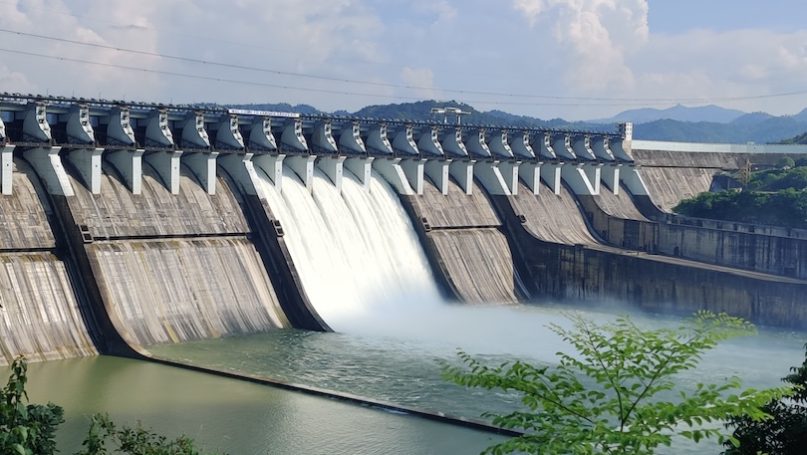
This case study is an excerpt from McGlinchey, Stephen. 2022. Foundations of International Relations (London: Bloomsbury).
Damming a moving body of water, such as a river, slows down and materially changes the flow and the landscape around it. It can also create a large area of water behind the dam (a manmade lake, or series of lakes), which is managed in different ways. Larger dams, or ‘mega dams’ are built to generate electricity (hydroelectricity), divert water for irrigation of crops or for other uses such as to store in lakes in case of drought and to help prevent flooding. While these are worthwhile outcomes, damming is a controversial issue for those in proximity to the project as it can lead to communities being relocated and losing their land. It also has a series of environmental impacts that affect the ecosystems associated with the river and the land around it. Beyond these issues, it also impacts international relations as when one state decides to dam a river that flows onwards to other states, it affects vital water flow downstream and can lead to disputes.
For example, the Nile has a drainage basin covering eleven African states. In 2011 Ethiopia began construction of a mega dam – the Grand Ethiopian Renaissance Dam – to provide hydroelectric power to address national energy shortages. Yet, downstream of the dam, which was completed in 2020, Egypt fears disruption to their shared water supply from the Nile – which accounts for 90 per cent of Egypt’s fresh water. Disputes like this can lead to serious incidents, even war. Due to this, the dispute has drawn in the African Union, a regional international organisation, and major powers such as the United States who have diplomatic and economic influence over the states concerned. Access to fresh water is likely to be one of the pivotal international issues in future years as climate change and a growing global population causes stresses on water supplies in key areas. Yet, within this category an underappreciated element is the role of civil society organisations and their focus on highlighting the effects of such projects at the local level, which we can see in a long-standing dispute over a damming project in India.
The Narmada River is the fifth largest in India. Plans to build over 3000 dams on the river to provide hydroelectric power and divert water to provide irrigation to agricultural land were developed through several decades, with construction beginning on a series of dams in the mid 1980s. An opposition movement, Narmada Bachao Andolan, was set up to give voice to locals who stood to lose their land as a result of the reservoirs and higher water levels caused by the dam projects – but also due to environmental concerns that would impact life at the local level. The movement used slogans such as ‘development wanted, not destruction’ and it quickly became a transnational network, drawing in international environmental and social non-governmental organisations. Working together, they put pressure on the project internationally and in doing so contributed to making it one of the world’s most debated development projects (Cullet 2007).
This global civil society mobilisation not only raised awareness of the issue beyond India, but it materially impacted an international organisation, the World Bank. This occurred after local activists visited the construction area of the Sardar Sarovar dam (pictured), one of the larger dams on the river, and found violations of environmental regulations and a concurrent lack of transparency over the full environmental and social impact. The World Bank had earmarked approximately $450 million dollars in financing for the project to the Indian government as part of its development activities. It soon found itself on the receiving end of questions from local activists, with these concerns amplified internationally by environmental groups. An independent review was held and the World Bank formally withdrew from the project in 1993, an unprecedented step, agreeing that environmental considerations were not adequate in the planning of the project.
Although the Indian government continued with the project in 1999 after several delays, the mobilisation materially impacted debates about global and local development policy, especially the social and environmental impact of mega dams and the effect they have on river systems and those who depend on them. Beyond just being a local example of activism, the long running dispute showed how local actions could be upscaled using transnational civil society practices to advocate for, and promote, different structures for how development funding was apportioned internationally. Additionally, local voices, originally unheard in the debate and not consulted with by the Indian government in its original plans, came to have their concerns amplified.
On a broader scale, the debates held through this episode have become symbolic, materially shaping development debates on later dam projects – such as the aforementioned Ethiopian dam on the Nile. For example, the debates raised by Narmada Bachao Andolan and their wider impact inspired the creation of the World Commission on Dams, a group that involved civil society groups, experts and academics together with government and non-governmental figures who worked together to shape international guidelines for dam building. This was an example of multistakeholder governance, a practice that harnesses global civil society in order to gain a result that has more legitimacy than – for example – a non-consultative governmental decision such as that made by India over the Sardar Sarovar dam.